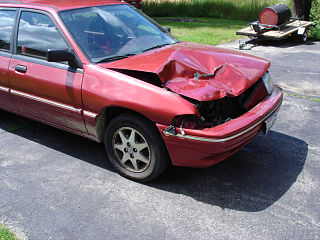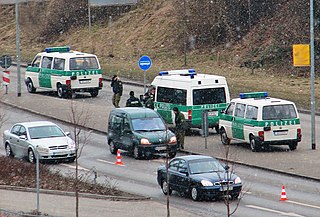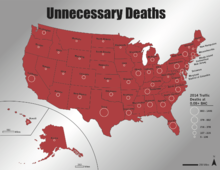Drunk driving is the act of operating a motor vehicle with the operator's ability to do so impaired as a result of alcohol consumption, or with a blood alcohol level in excess of the legal limit. For drivers 21 years or older, driving with a blood alcohol concentration (BAC) of 0.08% or higher is illegal. For drivers under 21 years old, the legal limit is lower, with state limits ranging from 0.00 to 0.02. Lower BAC limits apply when operating boats, airplanes, or commercial vehicles. Among other names, the criminal offense of drunk driving may be called driving under the influence (DUI), driving while intoxicated or impaired (DWI), operating [a] vehicle under the influence of alcohol (OVI), or operating while impaired (OWI).

Road traffic safety refers to the methods and measures used to prevent road users from being killed or seriously injured. Typical road users include pedestrians, cyclists, motorists, vehicle passengers, horse riders, and passengers of on-road public transport.

Driving under the influence (DUI) is the offense of driving, operating, or being in control of a vehicle while impaired by alcohol or drugs, to a level that renders the driver incapable of operating a motor vehicle safely. Multiple other terms are used for the offense in various jurisdictions.

Rumble strips are a road safety feature to alert inattentive drivers of potential danger, by causing a tactile vibration and audible rumbling transmitted through the wheels into the vehicle interior. A rumble strip is applied along the direction of travel following an edgeline or centerline, to alert drivers when they drift from their lane. Rumble strips may also be installed in a series across the direction of travel, to warn drivers of a stop or slowdown ahead, or of an approaching danger spot.

The National Traffic and Motor Vehicle Safety Act was enacted in the United States in 1966 to empower the federal government to set and administer new safety standards for motor vehicles and road traffic safety. The Act was the first mandatory federal safety standards for motor vehicles. The Act created the National Highway Safety Bureau. The Act was one of a number of initiatives by the government in response to increasing number of cars and associated fatalities and injuries on the road following a period when the number of people killed on the road had increased 6-fold and the number of vehicles was up 11-fold since 1925. The reduction of the rate of death attributable to motor-vehicle crashes in the United States represents the successful public health response to a great technologic advance of the 20th century—the motorization of the United States.

This is a list of numbers of motorcycle deaths in U.S. by year from 1994 to 2014. United States motorcycle fatalities increased every year for 11 years after reaching a historic low of 2,116 fatalities in 1997, then increased to over 5,000 around 2008 and then plateaued in the 4 to 5 thousands range in the 2010s. In nine years motorcycle deaths more than doubled from the late 1990s to 2008. Despite providing less than 1% of miles driven, they made up 15% of traffic deaths in 2012.

Transportation safety in the United States encompasses safety of transportation in the United States, including automobile crashes, airplane crashes, rail crashes, and other mass transit incidents, although the most fatalities are generated by road incidents annually killing 32,479 people in 2011 to over 42,000 people in 2022. The number of deaths per passenger-mile on commercial airlines in the United States between 2000 and 2010 was about 0.2 deaths per 10 billion passenger-miles. For driving, the rate was 150 per 10 billion vehicle-miles: 750 times higher per mile than for flying in a commercial airplane.
Sleep-deprived driving is the operation of a motor vehicle while being cognitively impaired by a lack of sleep. Sleep deprivation is a major cause of motor vehicle accidents, and it can impair the human brain as much as inebriation can. According to a 1998 survey, 23% of adults have fallen asleep while driving. According to the United States Department of Transportation, male drivers admit to have fallen asleep while driving twice as much as female drivers.

A random checkpoint is a military and police tactic. In a military context, checkpoints involve the setup of a hasty roadblock by mobile truck- or armored vehicle-mounted infantry to disrupt unauthorized or unwanted movement or military activity and to check for valid identification and search for contraband, fugitives, or weapons that are not permitted in civilian hands. Random checkpoints are set up to achieve surprise, as opposed to known permanently located checkpoints, which suspects could circumvent. They are often established in locations where they cannot be observed by approaching traffic until it is too late to withdraw and escape without being observed.

Wrong-way driving (WWD), also known as contraflow driving, is the act of driving a motor vehicle against the direction of traffic. It can occur on either one- or two-way roads, as well as in parking lots and parking garages, and may be due to driver inattention or impairment, or because of insufficient or confusing road markings or signage, or a driver from a right-hand traffic country being unaccustomed to driving in a left-hand traffic country, and vice versa. People intentionally drive in the wrong direction because they missed an exit, for thrill-seeking, or as a shortcut.

86 percent of people in the United States use private automobiles as their primary form of transportation to their workplace.

Road traffic collisions generally fall into one of five common types:

A traffic collision, also called a motor vehicle collision, occurs when a vehicle collides with another vehicle, pedestrian, animal, road debris, or other moving or stationary obstruction, such as a tree, pole or building. Traffic collisions often result in injury, disability, death, and property damage as well as financial costs to both society and the individuals involved. Road transport is the most dangerous situation people deal with on a daily basis, but casualty figures from such incidents attract less media attention than other, less frequent types of tragedy. The commonly used term car accident is increasingly falling out of favor with many government departments and organizations, with the Associated Press style guide recommending caution before using the term. Some collisions are intentional vehicle-ramming attacks, staged crashes, vehicular homicide or vehicular suicide.
The laws of driving under the influence vary between countries. One difference is the acceptable limit of blood alcohol content before a person is charged with a crime.

Worldwide, it was estimated that 1.25 million people were killed and many millions more were injured in motor vehicle collisions in 2013. This makes motor vehicle collisions the leading cause of death among young adults of 15–29 years of age and the ninth most frequent cause of death for all ages worldwide. In the United States, 40,100 people died and 2.8 million were injured in crashes in 2017, and around 2,000 children under 16 years old die every year.

Drunk driving is the act of driving under the influence of alcohol. A small increase in the blood alcohol content increases the relative risk of a motor vehicle crash.
Drunk walking describes people intoxicated by alcohol walking in public spaces. While there are long-standing social stigmas and laws against drunk driving, only more recently have the personal and social dangers of drunk walking become apparent. One study on pedestrians struck by vehicles found that alcohol users were twice as likely to cross against the signal or outside of a crosswalk than sober pedestrians. Alcohol use was also associated with more severe injuries and longer hospital stays.

People who are driving as part of their work duties are an important road user category. First, workers themselves are at risk of road traffic injury. Contributing factors include fatigue and long work hours, delivery pressures, distractions from mobile phones and other devices, lack of training to operate the assigned vehicle, vehicle defects, use of prescription and non-prescription medications, medical conditions, and poor journey planning. Death, disability, or injury of a family wage earner due to road traffic injury, in addition to causing emotional pain and suffering, creates economic hardship for the injured worker and family members that may persist well beyond the event itself.

Field sobriety tests (FSTs), also referred to as standardized field sobriety tests (SFSTs), are a battery of tests used by police officers to determine if a person suspected of impaired driving is intoxicated with alcohol or other drugs. FSTs are primarily used in the United States, to meet "probable cause for arrest" requirements, necessary to sustain an alcohol-impaired driving conviction based on a chemical blood alcohol test.

Two main questions arise in the law surrounding driving after having ingested cannabis: (1) whether cannabis actually impairs driving ability, and (2) whether the common practice of testing for THC is a reliable means to measure impairment. On the first question, studies are mixed. Several recent, extensive studies–including one conducted by the National Highway Traffic Safety Administration and one conducted by the American Automobile Association (AAA)–show that drivers with detectable THC in their blood are no more likely to cause car crashes than drivers with no amount of THC in their blood. Others show that cannabis can impair certain abilities important to safe driving –but no studies have been able to show that this increases the actual risk of crashing, or that drivers with THC in their blood cause a disproportionate number of crashes. On the second question, the studies that have been conducted so far have consistently found that THC blood levels and degree of impairment are not closely related. No known relationship between blood levels of THC and increased relative crash risk, or THC blood levels and level of driving impairment, has been shown by single-crash or classic-control studies. Thus, even though it is possible that cannabis impairs driving ability to some extent, there are currently no reliable means to test or measure whether a driver was actually impaired.

















